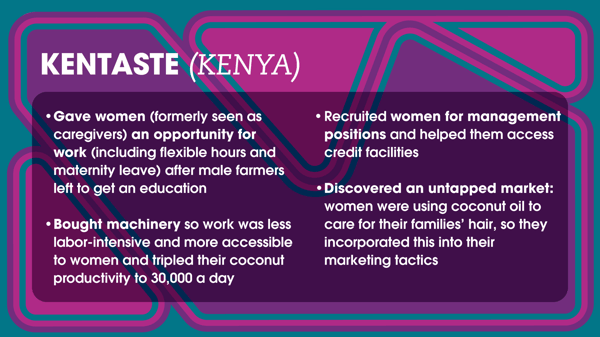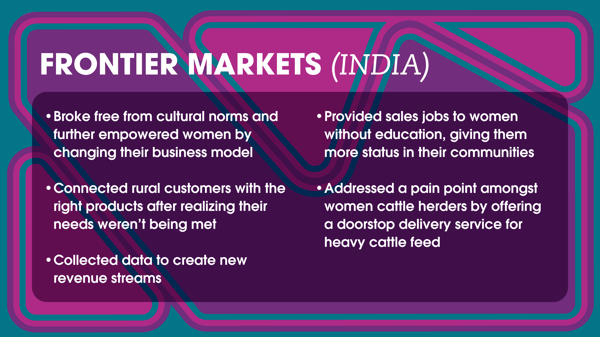A group that makes up half of society deserves access to the same products, jobs, opportunities, and resources.
Likewise, studies show a strong correlation between diversity and positive business outcomes — a 25 percent increase in above average profitability. Not to mention, striving for equity and inclusion is a positive and impactful contribution to society.
Gender diversity has become an important and urgent discussion that impacts today’s companies and their employees. Value for Women is a specialized advisory firm that helps companies move the needle on gender equity and inclusion by finding and testing solutions, encouraging women's involvement in economics, and linking with other organizations to promote change. In the same way, their educational resources have played a major role in Acumen's Gender Equity and Advancement Accelerator, which helps entrepreneurs grow to scale while advancing gender equity.
Both Acumen and Value for Women agree that much of this education should be accessible and available for anyone who is looking to make these advancements in their own work environment. We hope that the following content can act as a guidepost on your journey towards diversity and inclusion.
Value for Women defines a “gender forward business” as one that intentionally seeks to rectify gender inequalities by:
- Providing products and services that close gender gaps
- Supporting gender diversity through internal policies and practices in the workforce
- Strengthening inclusion and diversity across the value chain^
If you’ve already started growing to scale, taking on business duties, or don’t have a disposable budget, don’t worry—there are several ways you can incorporate these changes to your pre-existing business plan and practices.
As an entrepreneur and leader, you can adopt gender-inclusive practices that align with your current business policies and priorities. With resources from Value For Women, we have compiled an introductory guide of questions to ask of yourself and your company, as well as tips that can assist you in getting started. This guide will focus on three points of entry: workforce and leadership, the market, and the value chain.
1. Workforce and leadership
Gender diversity within a company’s leadership and workforce can lead to diverse perspectives, more creative problem solving, and efficiencies in your business. It can also contribute to a greater understanding of different clients’ perspectives. Concrete steps you can take to improve gender diversity in your leadership and workforce include:
- Using inclusive language in job ads, assessment criteria, and interview questions
- Creating a pipeline of future women leaders through training, networking, and mentorship
- Setting targets for women on the board and in management
- Employing clear policies and practices, such as:
- Anti-discrimination
- Anti-harassment
- Equal pay
- Parental leave
- Flexible work and/or childcare
- Standardized performance review
- Tracking sex-disaggregated HR data and identifying and mitigating discrepancies
Could gender bias be holding you back?
If you’ve already been trying to increase the gender diversity of your workforce and leadership but haven’t seen the results you’d hoped for, consider examining whether gender bias is holding you back in your approach to HR and team building. While some biases involve outwardly preferring one group over another (based on the basis of gender, age, race, ability, sexual orientation, etc.), bias can also be unconscious and may be affecting your perception of the world, impacting the ability for everyone to feel welcomed and able to succeed in your workforce.
Here are ten questions and considerations you can ask yourself and your colleagues to bring awareness to potential blind spots:
1. Who are you hiring?
- What are your recruitment processes?
- Are your job descriptions based on stereotypes?
*Tip: You can use a gender decoder tool to ensure that your roles and wording are inclusive.*
2. Qualifications
- Studies show that women are less likely to apply for a job unless they meet 100 percent of the qualifications, whereas men will apply when only 60 percent are qualified. Do your job descriptions encourage applications that don’t match the role completely?
*Tip: Explicitly state gender inclusion in your marketing and recruitment. Consider that some women may not have the same access to education and technology but still deserve an opportunity.*
3. Gender-inclusive businesses are known to attract the best talent
- Are you drawing in more women and women-identifying people by hiring women at the top?
- Do you advertise to a wide range of recruiters and sites to ensure the diversity of your candidates?
*Tip: Screen your applications from revealing gender so that they’re judged solely on their skills.*
4. Understand areas where gender inequality is at play
- Are women missing resources that allow them to reach the same goals as men? For example, are they unable to travel at certain times of the day due to safety concerns?
- Do they have a flexible schedule and can they work from home?
5. Performance bias
Women in leadership positions are known to be very beneficial to business, but they can often be overlooked because of unconscious bias.- Who are you promoting most often?
- Are you critiquing women fairly in comparison to men?
- Are you consciously or unconsciously paying people differently based on their gender?
- Learn more addressing bias in the workplace in our 2-hour course on Fighting Hate & Bias.
*Tip: Use a standard rubric and incorporate feedback from peers and teammates to reduce bias; incorporate sex-disaggregated data (where genders are separated) to track promotions and wages.*
6. Attribution & likability bias
- Do you view the same behaviors in men and women differently (i.e. assertive vs. abrasive, confident vs. demanding)?
*Tip: Identify double standards and point them out to your colleagues.*
7. Are women allowed the time to speak in meetings?
- Are their contributions valued equally compared to men's?
- Is space made for their ideas?
- Where are harmful gender norms at play?
*Tip: Provide training to managers and team members on gender sensitivity and unconscious bias.*
8. Maternity bias and policies
- Are there bad policies around parental leave, childcare, and flexible working hours?
- Are employees protected if they speak out against harassment?
9. Support systems and network
- Are you providing training groups, mentorship, or networking opportunities for women?
- Do women have the space to share openly about their difficulties at work?
10. Facilities
- Do you have separate, private, and adequate changing spaces, restrooms, or lockers for different gender identities?
.jpeg?width=400&name=image-1%20(1).jpeg)
Photo provided by Gender Equity and Advancement Accelerator, Regxta.
2. Market
From a global lens, women currently hold $20 trillion in buying power and will make up 75 percent of the world’s spending by 2028. This high-growth market of women customers spans all sectors, making it a formidable and highly opportunistic group to target. Here are three ways to consider them as customers:
1. Is your product or service too vague, general or gender-neutral, and does that gender-neutral model gear towards men as the average or default experience?
Make sure your product fits the market. Even if your product is gender-neutral, different genders don’t engage with that product in the same way. If you incorporate the needs of a marginalized group, you’re actually helping to make your product more accessible.
*Tip: You can collect sex-disaggregated data to understand different gender preferences for each product and get a broader range of information.*
2. Are you using a phone tracker to track data?
If so, you might not be getting the full picture. Men and male-identifying people carry their phones in their pockets, which pick up on more info than for women and women-identifying people, who tend to carry their phones in their handbags.
3. Are you incorporating gender-inclusive marketing strategies?
If you better understand your consumers’ needs before you design your product or service, you will save time and money in the long run and may gain the opportunity for new customers in an untapped market. Applying inclusivity to products early on will ultimately reach the widest range of people and increase the bottom line. When designing gender-inclusive and gender-specific marketing strategies, consider differences between men and women in terms of:
- Messaging and imagery that resonates
- Channels that reach
- Purchase patterns (where, how, who)
*Tip: Understand your audience! Just because women aren’t buying your product doesn’t mean they’re not using it—or they may be using it differently than its intended use.*
.jpg?width=600&name=mbegu-solar-webb-2%20(1).jpg)
Photo provided by Gender Equity and Advancement Accelerator participant, Mbegu Solar.
3. Value chain
Gender-diverse value chains make for stronger value chains, both on the supply and distribution side. Having a narrow set of suppliers is risky due to supplier shocks. If you diversify your market with women-owned and led businesses, you secure and protect your value chain. Here are four advantages:
1. Your suppliers will have varying specialties that will expand your business as customer needs develop.
2. Women distributors appeal to women customers and have been shown to over-perform in sales — regardless of a customer gender — due to collaborative and listening-based sales practices.
3. Save time and money by examining gender-specific differences and barriers in distribution.
4. Gain access to premium markets that women customers are willing to pay more for (currently 40-60 percent of women in the US and Europe pay extra for ethical sourcing).
By thinking about your supply and distribution network through a gender lens—pausing to consider the gender of your suppliers and distributors—you can identify barriers and respond with strategies to help overcome them.
A common misunderstanding is that to be more gender-inclusive in your value chain, you simply need to bring in more women. And while this is definitely a key aspect of it, there is more to it than just that.
Ultimately, the aim of gender-inclusive business practices is to understand and address gender inequalities and provide the relevant support to each group so that they can achieve similar outcomes. Here are some concrete steps you can take to grow a gender-inclusive value chain:
- Adopting an internal and external-facing vendor code of conduct that explicitly states your company’s support for gender inclusion (here's a template provided by WEConnect International)
- Setting targets for women and/or women-led suppliers and distributors
- Investing in the women in your value chain as your business grows, such as providing capacity building or financing for tools
- Offering gender-sensitive contracting terms like shorter payment periods, often more favorable for women-led businesses (which are typically smaller), as longer payment terms can create challenges in managing cash flow and resources






